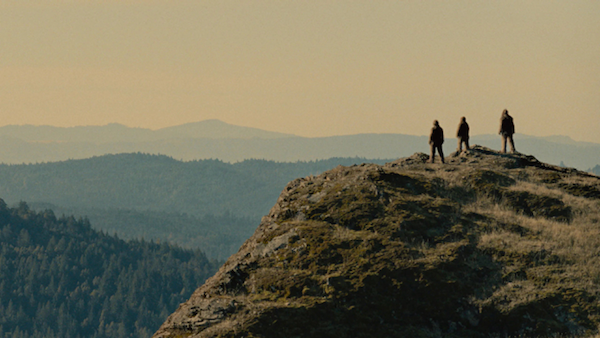Movie review by Greg Carlson
Surely one of the year’s unlikeliest and most wondrous theatrical experiences, “Sasquatch Sunset,” from beloved indie storytellers David and Nathan Zellner, premiered at the Sundance Film Festival to a range of critical responses that match the breadth of the film’s own expansive agenda. Following a quartet of hairy hominids – of the familiar bipedal cryptid sort that has fueled legends of Bigfoot and Yeti in cultures around the world – the movie communicates every one of its concerns without a single spoken word. Chapters divide the action into the four seasons, and “Sasquatch Sunset,” as implied by its title, tackles ideas large and small under the impending twilight signaled by encroaching humans.
Costumed in shaggy, anatomically-detailed bodysuits and stunning foam latex prosthetics by veteran effects designer Steve Newburn, the principal creatures are played by Riley Keough, Jesse Eisenberg, Christophe Zajac-Denek, and Nathan Zellner. Each member of the ensemble commits fully to the enterprise, conveying a wholly believable authenticity by balancing vocalized grunts, hoots and physical movements with astonishingly expressive and soulful performing done with the eyes. Personalities emerge, and with them viewers discover the recognizably human in the group’s relational dynamics. As the only female in the unit, Keough differentiates herself by teaching us much about the unique challenges of maternity.
The intensity of the movie’s environmental message slowly but surely increases throughout the duration of the 89 minute running time. The Zellner brothers, who screened the short “Sasquatch Birth Journal 2” at Sundance in 2011 (the contents of which effectively get remade in one of the feature’s tour de force sequences), don’t limit the action to a single theme, and alongside the warnings about consuming and/or mishandling natural resources and the endangerment of species glows a dazzling rainbow of experiences: alarms signaled by rhythmic beating of sticks, shelters built from leafy branches, mushrooms tasted with dire results, sexual intercourse by turns accepted and rebuffed, encounters with other forest-dwelling animals, and more.
The recognition of the boundaries between the unspoiled, primeval range and the presence of modern humans results in some of the film’s most outrageous and hysterical gags as well as some tragic and startling outcomes. The Zellners indulge an absolutely giddy sense of humor that launches a larger than average number of laugh-out-loud moments in scene after scene. Unimaginative killjoys, complaining that behaviors involving urine and feces are merely “gross,” miss the bigger picture. “Sasquatch Sunset” acknowledges the sense of smell so consistently one can practically taste both inviting fragrance and tangy stench.
In “2001: A Space Odyssey,” Stanley Kubrick distilled “The Dawn of Man” to a single moment of emerging consciousness via tool use, as Dan Richter’s Moonwatcher weaponizes a bone against rival One Ear. “Sasquatch Sunset” is, in many satisfying ways that imbue the movie with its magnetic pull, “The Dawn of Man” inflection point staged again and again. The best of these signposts is performed by Zajac-Denek, whose Sasquatch externalizes a previously internal kind of conversation or thought process by using his hand, in the manner of Señor Wences and Johnny, to anticipate both a sense of self and the separation of the mind and the body.
In true Zellner fashion, it’s a note simultaneously funny and profound.
